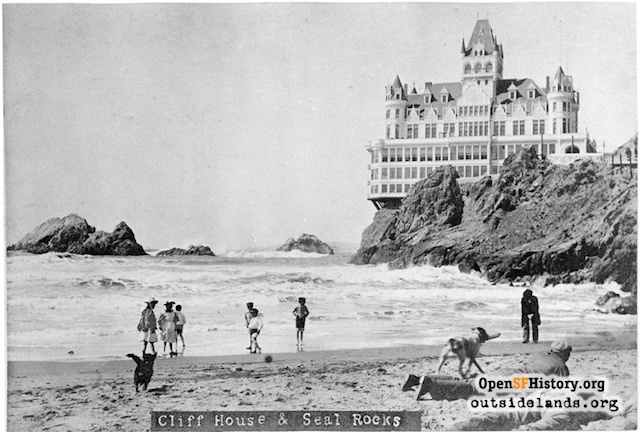You'd be forgiven for assuming that Cliff House, a building that's super casually very precariously perched on some rocks at the edge of a continent, was built on a dare, or maybe as part of a bet. Certainly the spirit of the place is one of spectacle, and the site has been host to strange stunts and escapades since real estate tycoon Charles Butler first installed a clapboard structure there in 1863.
The 160-acre location, as San Francisco storyteller Gary Kamiya explained in his Chronicle history column a few years back, had previously been Chambers' Potato Patch. But Butler saw in the site the makings of a resort destination. One problem: The journey from more hospitable, inhabited parts of town kept Cliff House isolated. Therefor Butler built a toll road all the way out to Ocean Beach. The folks willing to pay the $1 fare for a round-trip were the Hearsts, the Stanfords, and other well-to-do families who enjoyed views, champagne, and oysters. Mark Twain even made the journey, though his first recollection of it, "ocean air that swells the lungs" was undercut by his second, when the air was instead "cold and benumbing."
After a decade of success among the rich, Golden Gate Park opened, as did public roads to the beach. Now accessible to plebeians, the destination lost its upscale luster. Kamiya writes that it became a "French restaurant," an establishment perhaps serving haute cuisine but more focused on private rooms which waiters knew better than to enter uninvited.

The state of Cliff House's ill-repute bothered new neighbor Adolph Sutro, the businessman and engineer who would later construct his Sutro Baths below. Sutro had a small cottage in the area, but decided to buy Cliff House in 1883 to clean it up. In the words of Mary Germain Hountalas and Sharon Silva, the authors of The San Francisco Cliff House, he wanted to take the "garter-snapping crowd” and make of it “a respectable resort with no bolts on the doors or beds in the house.”
For thrills, the view alone would have to do, although daredevils provided wholesome entertainment in the form of acrobatics. According to a follow up history piece from Kamiya published this month, tightrope walkers successfully made their way from Cliff House to Seal Rocks in 1865 and 1866.
At one point a suspension bridge was built for Cliff House guests, but that move ended badly when the bridge flipped over, dumping several into the water. They survived. In 1889, the popular champion swimmer Captain Jack Williams took up a weeklong amphibious residency among the rocks below Cliff House: Along the lines of a Harry Houdini, Williams would swim with his hands and legs tied and smoke cigars while treading water.
The structure of Cliff House was also a spectacle from which proprietors sought profit. In 1887, a schooner loaded with explosive dynamite and black powder collided with the rocks below the structure, exploding and destroying a wing of Cliff House with it. 50,000 people showed up the following day to see the carnage, picking up pieces of the schooner that had flown as far as a mile away. Seeing an opening, proprietors invited gawking guests inside to buy drinks. Though the wing was repaired, a massive fire in 1894 wrought real havoc. But Sutro, recently elected mayor, rebuilt Cliff House even grander than before. Unfortunately, the new Cliff House was done in by prohibition, and it closed from 1925 to 1936 at which time it was bought by George and Leo Whitney. The owners of Playland-at-the-Beach, they sold it in 1977 after that amusement park fell on hard times.
The National Park Service bought Cliff House at that time, and they now lease it on a long term basis to the Hountalas family. You've probably been. That the NPS owns the property is sort of in keeping with quote from a 1905 plan for the site dug up by Mashable. "The Cliff House should be condemned," a city planner proclaimed, "removed and a concourse providing some slight shelter substituted, thus opening to the view the sweep of the headlands to the north and the ocean from Cliff House road." Maybe it should, although I rather like it as is. The real spectacle, after all, is the headlands: precarious and preposterous all on their own.
Related: Trove Of Historical SF Photos Now Available For Your Browsing Pleasure
Second Cliff House and visitors on Ocean Beach, circa 1900, via Open History SF.
